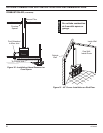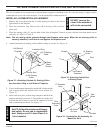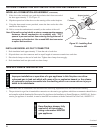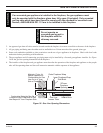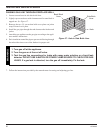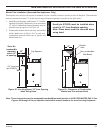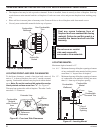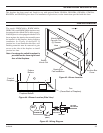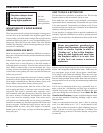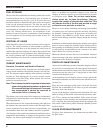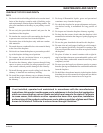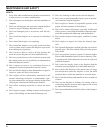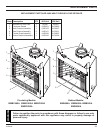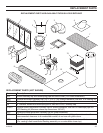
34 61D0006
FIREPLACE OPERATION
ADVANTAGES OF A WOOD BURNING
FIREPLACE
These are practical and ecological advantages of using wood
as a fuel. Also to be considered is the aesthetic appeal. Most
of us consider a wood fire with nostalgia. We enjoy the aroma
and find the flickering light of a cozy hearth reminding us of
things past. Wood has a low ash content. The little ash that
remains after burning is useful in home gardening as a fertil-
izer and soil conditioner.
WHICH WOODS ARE BEST?
Each wood species offers something different in aroma or
heat value. You should consider your needs and desires before
building your fire.
Softwoods, like pine, spruce and fir are easy to ignite because
they contain a lot of resin. However, a fire built entirely of
softwoods burns out quickly. You also must add wood more
often. While a softwood fire is not too desirable for a long
evening, itʼs fine in the morning when you want quick warmth
or late in the evening when you want a fire that will burn out
before you go to bed.
On occasion when a longer fire is desired, itʼs best to combine
softwoods with the heavier hardwoods such as ash, beech,
birch, maple, oak and hickory. Hardwood burns slower, with
shorter flames, and produce steady, glowing coals.
For the most pleasing aroma, burn the wood of fruit trees
such as apple and cherry, or nut trees such as beech, hickory
and pecan. This wood is generally more expensive, but a
little combined with other wood goes a long way. Start your
fire with a mixture of softwood and hardwood. Add some
fruit or nut wood for nostalgic aroma. Since most woods
will not burn well when freshly cut, the wood you purchase
should be reasonably dry. Purchase logs that will fit when laid
across your grate. Ask that the larger, heavier logs be split.
Kindling should be short, easily split lengths of softwood,
lumber yard or mill scraps, or twigs and branches gathered
from your yard.
Fireplace damper must
be fully opened when
using a gas appliance.
WARNING
See Gas
Appliance
Installation for
more guidelines.
HOW TO BUILD A BETTER FIRE
The first three fires should be of moderate size. This lets the
fireplace adjust to the heat and the bricks to cure.
First, make sure your room is well ventilated, your damper
open and the flue is unobstructed. Then make sure your wood
is dry and seasoned. Unseasoned wood burns poorly. If you
use unseasoned wood with poor ventilation or an obstructed
chimney, smoking could occur.
If your fireplace is equipped with an outside combustion air
assembly, open the combustion air inlet by pushing upward
on the lever located above the firebrick on the left side of the
firebox.
Never use gasoline, gasoline-type
lantern fuel, kerosene, charcoal lighter
fluid, or similar liquids to start or
“freshen up” a fire in this fireplace.
Keep all such liquids well away from
the fireplace while it is in use. Use
of this fuel can cause a serious
explosion.
WARNING
Prepare your fire by placing two logs on the iron grate or fire
basket, and laying the tinder between them. Tinder may be
dry scrap paper, twigs or bark. On top place a small hand-
ful of twigs or split softwood kindling. Place more dry logs
over this base. Keep logs close together, as narrow air spaces
between them promote better drafts. Heat reflected between
adjacent surfaces aids in raising and maintaining combustion
temperatures.
Youʼll need a minimum of three logs, preferably four, to
make a good fire. Add kindling and new logs as needed to
rekindle a dying fire. New logs should be added at the rear
grate after raking the coals toward the front. Note: Do Not
Overfire the Fireplace. Overfire conditions happen when
you use large amounts of kindling, building scraps or other
improper fuels.
Ashes are important because they form a bed of glowing
coals. Let ashes build up to 1" to 2" on the bottom of the
grate. Excess ashes can be used to check a flaming fire or to
“bank” your fire. Cover the logs with ashes. A “banked” fire
will hold glowing coals for 8-10 hours, thereby saving a fire
for later use.



